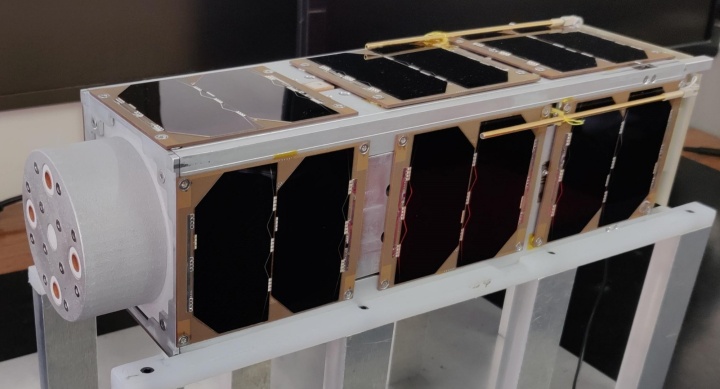On July 13, 2022 at 14:13, the VEGA-C rocket (ESA) took off from Kourou, French Guiana, on its maiden flight. On board was the Italian satellite GreenCube, which is equipped with the PETRUS (Pulsed Electric ThRuster of University of Stuttgart) propulsion system developed by the Institute of Space Systems (IRS) of the University of Stuttgart.
PETRUS is a relatively simple, robust, and inexpensive electric space propulsion system. It is therefore particularly well suited for attitude and orbit control as well as orbit transfer for very small satellites. It is also flexible and can be adapted for almost any satellite platform. PETRUS was developed over a period of five years with the support of the European Space Agency ESA. It was then specifically adapted for the mission with the GreenCube satellite – with support of the Italian Space Agency ASI.
GreenCube has a length of 30 cm and a base area of 10 cm by 10 cm. Inside a compartment with a diameter of no more than 10 cm is PETRUS – a system of four clustered individual propulsion units. On one hand, the distribution of the propulsion over four units provides security if one of them should fail. On the other hand, it provides a higher thrust. According to Dr. Georg Herdrich, who heads the “Plasma Wind Tunnels and Electric Propulsion, Space Transportation” working group at IRS, the high propellant exit velocities will save fuel and thus weight.
PETRUS needs to make GreenCube rotate for the experiment
The GreenCube satellite does not need to be propelled in space. That is because the required orbit energy is achieved by the rocket. However, PETRUS can support the biological experiment of La Sapienza University in Rome on board the satellite. “For the experiment in which plants are to be grown and observed, a uniform temperature distribution in the satellite is essential,” says Herdrich. “If this is not the case, PETRUS ensures that GreenCube’s rotation can be increased such that the temperature can be distributed by the movement in the sunlight.”
The second task of PETRUS is to prove its capabilities as a general propulsion system for space applications through various functional tests in space after the biological experiment has been completed. Herdrich and his team hope to gain considerable knowledge from this because the operating characteristics of PETRUS will be compared indirectly with a sister system on the ground.
The IRS team is confident that PETRUS will meet the requirements in space. “We are already working with the University of Würzburg to adapt PETRUS for their SONATE2 satellite,” says Herdrich. There will then hopefully be a second flight into space for PETRUS.
Partners
In order to adapt PETRUS for its first mission with GreenCube, the Stuttgart scientists worked with several partners:
- The team of Prof. Fabio Santoni at University La Sapienza in Rome was responsible for the development of the satellite as well as adaptation and integration activities regarding the PETRUS propulsion system.
- The team of Prof. René Laufer at Luleå University of Technology (LTU) in Sweden developed aspects of the system design and parts of the interface engineering.
- The ArianeGroup company headed by Christoph Montag supported the environmental tests required for the PETRUS propulsion system. Montag is a former IRS employee and has been instrumental in the development of PETRUS.
Expert Contact:
PD Dr. Georg Herdrich, University of Stuttgart, Institute of Space Systems, phone 0711 685-62412, Email
M. Sc. Felix Schäfer, University of Stuttgart, Institute of Space Systems, phone 0711 685-62452, Email


